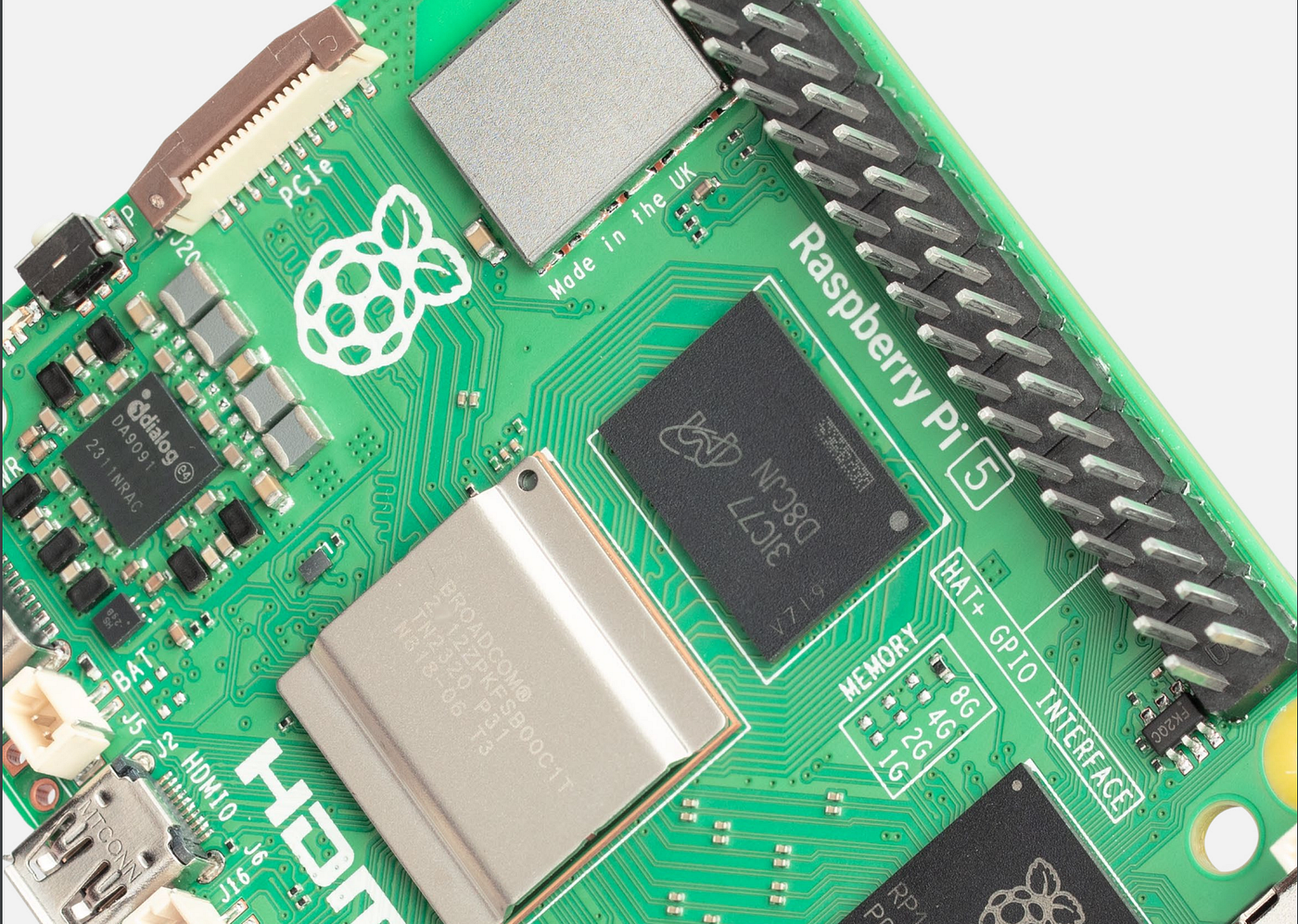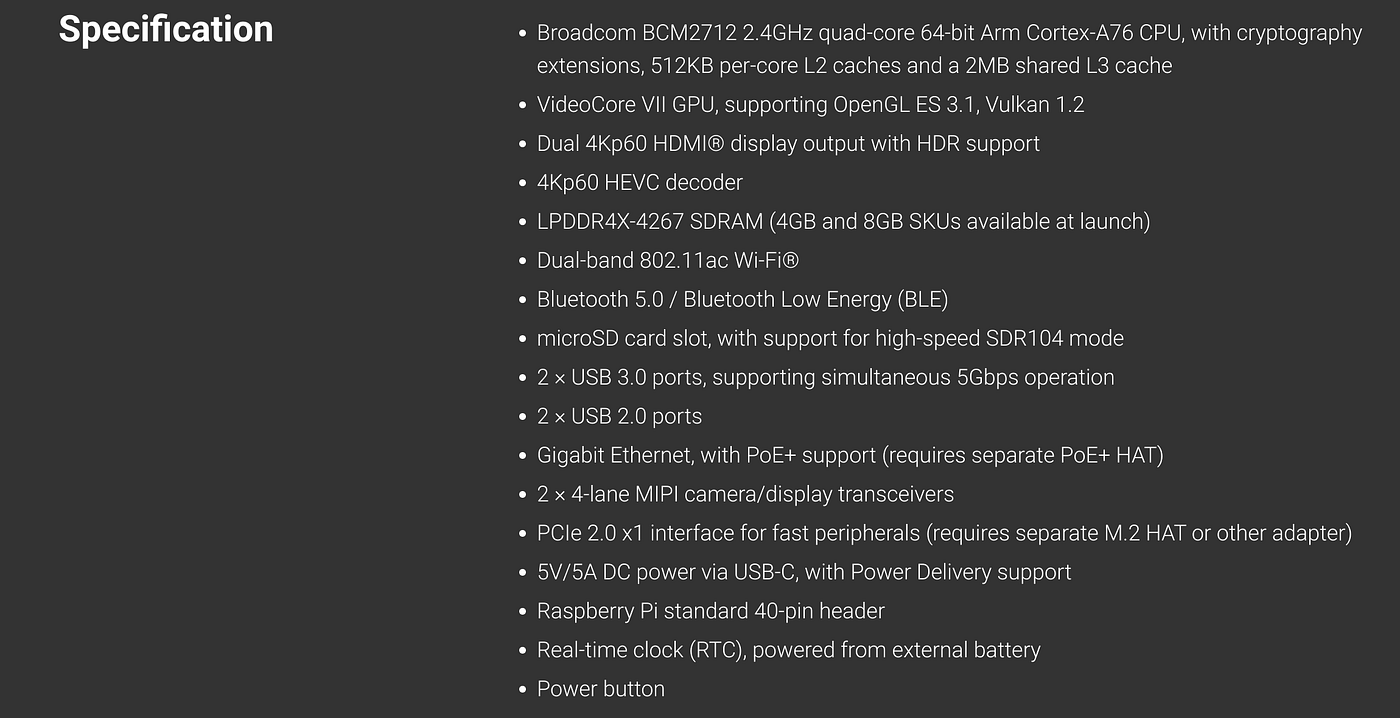Exploring Hardware: The Raspberry Pi 5
The Pi 5 is a huge upgrade over the Pi 4, but is it worth the money?
If you aren’t a medium member, you can read with no paywall via substack
It’s no real secret that as hardware enthusiasts we have a soft spot for the Raspberry Pi board. This little powerhouse has grown far beyond the specs of the original Raspberry Pi design to feature onboard wi-fi, up to 8 GB of RAM and quad-core processors allowing for an expansion beyond its originally intended role. In fact, these boards became such hot property during the COVID years that shortages were the norm and for a while, you couldn’t get your hands on a board for love or money.
While the pandemic demand has eased and the chip shortage has been somewhat restored we’ve finally been graced with an upgrade to the Raspberry Pi series of boards with the new Raspberry Pi 5. In today’s article, we’ll be having a look at the Pi 5, checking out some of its upgraded features and exploring what uses we might find for it.
Why The Pi?
As technology has grown, the price of computing equipment has also reduced. While the early internet days demanded a laptop or possibly even a desktop or rack-based system for home experimentation, these days it’s easy to spin up a cloud server for home-lab purposes and there’s also a range of single-board computers as well.
Aiming to provide a compact, power-efficient device that’s able to be used for a myriad of circumstances one of the best initial uses of the Pi came from the fact it had GPIO pins. These pins allowed for the connection of a large array of sensors, accessories and Hardware Attached on Top (HATs). While the early boards weren’t exactly computing powerhouses, over the years they’ve grown to become decent machines in their own right, enabling users to learn Linux, use them for home labs or even use them as pen-testing systems, running everything from Kali Linux to Parrot OS.
In each new iteration, we’ve seen a significant increase in onboard specs and additions of new hardware allowing for the new generation to be a far more capable machine than the one that came before it. In this regard, the Pi 5 is no different, and while things like backwards compatibility will have to be considered if you’re upgrading existing projects, if you’re starting a new one then you’ll have a far more capable machine at your disposal.
New Features, Faster
Like any computer, the beating heart of the Pi’s system is of course its processor, and while the Pi 4 was a quad-core device as you’d expect, the Pi 5 obviously won this battle, with a significant upgrade over the chips prior. Sporting a 2.4ghz quad-core CPU along with an expanded cache, the new generation Pi offers large amounts of potential for those who wish to use it as an actual computing device and a genuine ability to run as a simple desktop system with the ability to surf the web, use social media or even use it for simple coding tasks.
The GPIO pins remain unchanged however taking a look at the rest of the board we’ll also see an expansion of features that enable the easy addition of cooling systems, solid-state drives and other useful pieces of hardware.
Given the standard Pi doesn’t ship with an onboard EMMC this means that typically, on most Pi projects you’ll find people using the onboard SD card to store the operating system. While this feature hasn’t changed on the 5 what has changed is the addition of a PCI Express interface meaning that it’s now trivial to supply the Pi with high bandwidth peripherals making it easier to boot from SSD. This feature means that configuring the Pi to run as a simple, home server is a lot easier. In fact, a simple home server is one of the best projects to tackle if you have an interest in learning about Linux and configuring hardware.
Moving across the board we’ll also find a port dedicated to onboard cooling. While the Pi 4 always had the ability to provide cooling via the GPIO pics, often this made it harder to apply hats and use the pins for other tasks. The Raspberry Pi Foundation took this to heart and as a result, it’s much easier to apply active cooling strategies to the new generation board.
Two of the most heard complaints about the previous Pi 4 were its poor performance with video and its lack of a hardware-based power button. Both of these complaints have also been rectified, with a hardware power button used for the first time, as well as a significant upgrade around video processing.
Using an 800mhz VideoCore GPU and a dual 4Kp60 output over HDMI the 5 makes it easy to assemble a dual monitor system, and generally speaking, provides a far smoother desktop experience for those who lean in that direction.
Which OS?
One of the best options when acquiring a Pi is the vast array of Linux-based operating systems that are available to its users. While in the early days, the choice really only was the Raspbian-based operating system these days there’s an almost overwhelming choice of options. Here are a few of the best that will allow you to get your home lab-based project up and running quickly and easily.
OSMC Media Server:
If you’re looking for a feature-rich, turnkey media solution, OSMC (Open Source Media Center) is a superb choice. With OSMC, you can enjoy seamless media streaming, local playback, and access to a vast library of add-ons. OSMC delivers an easy-to-configure, entertainment experience that’s particularly well suited to the new hardware on Raspberry Pi 5.
Kali Linux Pentesting Box:
If you’ve followed for any period of time you’ll probably know that we think cybersecurity experimentation is great fun. Up your learning experience with a hardware-based Kali Linux install. With all that you’ll need to get started with hacking tools and the terminal, Kali or any other pentester distro will give you the chance to supercharge your learning. Read our article on installing Kali on the Zero W
Retro Pie Gaming:
Retro Pi offers a simple way for you to relive the gaming experience of your youth. While you’ll need to provide your own ROMs (these are easily available online) there is also a retro pi image available online and you’ll find an abundance of USB-based retro controllers on places like eBay as well. This means that a simple, retro gaming-based platform is typically a half-day project. You’ll pick up some rather useful skills while building it as well. Find the Retro Pi Image Here.
Home Assistant OS:
Home Assistant OS gives you the ability to pair your new Raspberry Pi board with an assortment of different hardware devices that come together to provide automation and monitoring systems for just about any system you care to think of. From something as simple as automating your lights at home to something as complex as automated garden watering or pet feeders, Home Assistant OS gives users a great interface for configuration as well as adaptability around integrating or expanding useful sensors within the system. Read the Home Assistant OS tutorial here.
OpenWRT Router:
OpenWRT provides open-source firmware for an assortment of Hardware-based devices. While typically, these are older commercial routers or switches you’ll also find images available for most Raspberry Pi devices.
One of the best uses of this firmware can be in putting together a simple, wi-fi enabled router. This can be used with a VPN as a travel router, providing you with additional security as you go about your travels. Connect your devices to your WRT-powered Raspberry, connect the Raspberry to your hotel wi-fi and hey presto. Security upgrade. Read about OpenWrt via this link.
FlightAware ADS-B Flight Tracker:
While you’ll also need an RTL-SDR dongle for this one, FlightAware provides a simple image that allows you to configure your own ADS-B receiving station at home. While its performance will depend on configuration and antenna specification even an indoor system should allow you to receive some aviation-based signals and then view them on the map on your own web-based server. Read our article about configuring an ADS-B Tracker
Upcoming Projects
If you’ve enjoyed reading this article, then you’re in luck because we’ve just got our hands on a new Raspberry Pi 5, complete with a cooling system, enclosure and solid-state drive to power it. So, over the next few months, you can expect to see more from this little machine as we test it out in a wide range of roles.
We’ll look at using its raw computing power, explore some of the projects we can tackle with hardware-based systems and even a walk-through or two, that will show you how to tackle hardware-based projects on your own. There will also be some benchmark tests as we explore some of the performance variations between the 5 and the previous generation Pi 4.
So as such, we’re also open to suggestions as to what you’d like to see tutorials on. Do you have a project or idea you’d like to tackle with a Pi? Let us know in the comments or send an email directly. Or if you’ve already built a project using a Pi, share it so others can see your creation and get inspired as well. When you can pair software AND hardware, the only real limit is your imagination.
Medium has recently made some algorithm changes to improve the discoverability of articles like this one. These changes are designed to ensure that high-quality content reaches a wider audience, and your engagement plays a crucial role in making that happen.
If you found this article insightful, informative, or entertaining, we kindly encourage you to show your support. Clapping for this article not only lets the author know that their work is appreciated but also helps boost its visibility to others who might benefit from it.
🌟 Enjoyed this article? Support our work and join the community! 🌟
💙 Support me on Ko-fi: Investigator515
📢 Join our OSINT Telegram channel for exclusive updates or
📢 Follow our crypto Telegram for the latest giveaways
🐦 Follow us on Twitter and
🟦 We’re now on Bluesky!
🔗 Articles we think you’ll like:
- Software Defined Radio & Radio Hacking Pt 1
- OSINT Investigators Guide to Self Care & Resilience
✉️ Want more content like this? Sign up for email updates



























